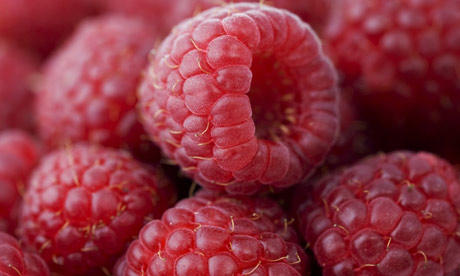Galaxy's Centre Tastes Of Raspberries And Smells Of Rum, Say Astronomers
Ian Sample, science correspondent
guardian.co.uk, Tuesday 21 April 2009 00.05 BST
The hunt for chemicals in deep space that could seed life on other planets has yielded a large, fruity molecule

Ethyl formate, which gives raspberries their flavour and smells of rum, has now been found in deep space. Photograph: Tim Graham/Getty
Astronomers searching for the building blocks of life in a giant dust cloud at the heart of the Milky Way have concluded that it tastes vaguely of raspberries.
The unanticipated discovery follows years of work by astronomers who trained their 30m radio telescope on the enormous ball of dust and gas in the hope of spotting complex molecules that are vital for life.
Finding amino acids in interstellar space is a Holy Grail for astrobiologists, as this would raise the possibility of life emerging on other planets after being seeded with the molecules.
In the latest survey, astronomers sifted through thousands of signals from Sagittarius B2, a vast dust cloud at the centre of our galaxy. While they failed to find evidence for amino acids, they did find a substance called ethyl formate, the chemical responsible for the flavour of raspberries.
"It does happen to give raspberries their flavour, but there are many other molecules that are needed to make space raspberries," Arnaud Belloche, an astronomer at the Max Planck Institute for Radio Astronomy in Bonn, told the Guardian.
Curiously, ethyl formate has another distinguishing characteristic: it also smells of rum.
The astronomers used the IRAM telescope in Spain to analyse electromagnetic radiation emitted by a hot and dense region of Sagittarius B2 that surrounds a newborn star.
Radiation from the star is absorbed by molecules floating around in the gas cloud, which is then re-emitted at different energies depending on the type of molecule.
While scouring their data, the team also found evidence for the lethal chemical propyl cyanide in the same cloud. The two molecules are the largest yet discovered in deep space.
Dr Belloche and his colleague Robin Garrod at Cornell University in New York have collected nearly 4,000 distinct signals from the cloud but have only analysed around half of these.
"So far we have identified around 50 molecules in our survey, and two of those had not been seen before," said Belloche.
The results are being presented today at the European Week of Astronomy and Space Science at the University of Hertfordshire.
Last year, the team came tantalisingly close to finding amino acids in space with the discovery of a molecule that can be used to make them, called amino acetonitrile.
The latest discoveries have boosted the researchers' morale because the molecules are as large as the simplest amino acid, glycine. Amino acids are the building blocks of proteins and are widely seen as being critical for complex life to exist anywhere in the universe.
"I wouldn't be surprised if we find an amino acid out there in the coming years," said Belloche.
Previously, astronomers have detected a variety of large molecules, including alcohols, acids and chemicals called aldehydes.
"The difficulty in searching for complex molecules is that the best astronomical sources contain so many different molecules that their 'fingerprints' overlap and are difficult to disentangle," Belloche said.
The molecules are thought to form when chemicals that already exist on some dust grains, such as ethanol, link together to make more complex chains.
"There is no apparent limit to the size of molecules that can be formed by this process, so there's good reason to expect even more complex organic molecules to be there," said Garrod.